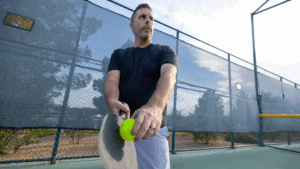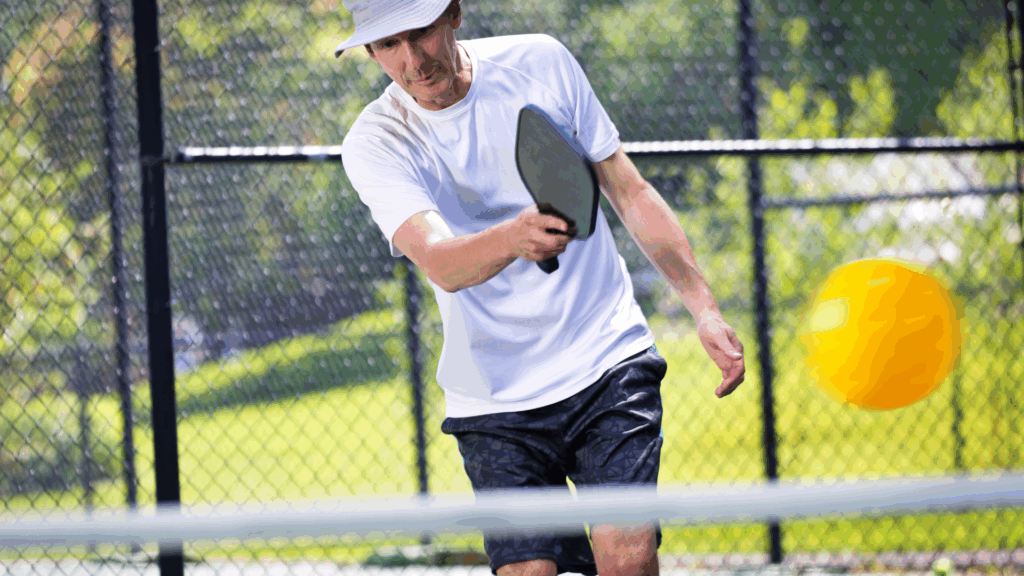
Pickleball is exploding across the United States, and 2025 is the year we turn raw enthusiasm into next-level skill.
Everywhere you look—public parks, private clubs, suburban cul-de-sacs—people are slapping plastic balls and grinning ear to ear.
Last season the player base hit 19.8 million, a 45.8% jump from the year before. Participation isn’t just bigger; it’s younger and more balanced.
The fastest-growing slice is the 25-to-34 crowd at 2.3 million players, but kids and seniors are right behind, proving that pickleball’s “for all ages” slogan actually sticks. Gear sales followed suit: 1,200-plus new paddle models and 81 fresh ball types received approval during 2024, meaning choice is rich and technology is racing ahead.
With that many fresh faces and fancy paddles, the burning question becomes:
How do you improve efficiently rather than just rally mindlessly?
Coaching pathways are answering the call. Certified instructors multiplied six-fold in the past two seasons, fueled by programs from the Professional Pickleball Registry, Pickleball Coaching International, and even crossover licenses from the USPTA.
Pair that with ball machines that fire serves at seventy miles per hour, AI video apps that dissect footwork frame by frame, and marketplaces such as TeachMe.To that book a private lesson in two taps—suddenly anyone, anywhere can access pro-level guidance.
Yet the sheer volume of drills, gadgets, and YouTube tips can feel as dizzying as a topspin lob on a windy day. Players need a clear road map, not another firehose of random advice.
That is where this guide comes in. Over the next sections we will break down six core pillars of pickleball mastery, each packed with field-tested drills and strategy:
Serve Techniques: Own the rally from the first bounce.
Dinking: Control the kitchen with feather-light precision.
Third Shot Drops: Neutralize returners and advance to the no-volley zone.
Volleys & Net Play: Develop lightning-quick hands and reset savvy.
Footwork Drills: Build the engine that powers every swing.
Partner Communication: Turn two individuals into a seamless unit.
Expect each area to deliver measurable targets, modern rule nuances, and level-specific tweaks—so whether you are just learning to keep score or hunting a bump in your DUPR rating, you will know exactly where to focus. We will keep paragraphs tight, action verbs sharp, and data fresh. No fluff, no stale tactics, only what is working in recreation centers and pro brackets right now.
Pickleball’s magic has always been its blend of community and competition. Master the fundamentals, sprinkle in a dash of advanced flair, and you’ll elevate not only your own play but everyone’s fun on court. Ready to dive deep?
Grab a paddle, cue the ball machine, and glide to the next section where we start with the all-important serve. Game on!
Serve Techniques
Your serve is the only time you control the ball unopposed—treat it like the opening move in chess, not a casual tap to start play.
Key 2025 Rule Updates
Excessive Spin On Toss: Still disallowed, so focus on paddle speed rather than tricky releases.
Paddle-Drop Serve: You may now let the ball fall from the paddle face before contact, giving beginners a more reliable option.
Rally Scoring Trials: Some clubs award a point on every rally, which makes each service fault feel twice as costly.
Building A Reliable Power Serve
Goal: Land deep in the back third of the court at shoulder height to force a weak return.
Drill: Baseline Targets: Place four cones in each corner and hit 20 serves, aiming to finish with at least 15 inside the target zone.
Progression: When you meet the 75 % mark, add a modest topspin swing path to keep the bounce low without sacrificing accuracy.
Metric: Track first-serve percentage during games; a strong benchmark is 85 % or better.
Mixing Variety To Disrupt Rhythm
High-Arc Serve: Pushes defenders backward and buys you time to step inside the baseline.
Surprise Short Lob: Exploits opponents who habitually stand deep; practice depth control so it dies just inside the service line.
Body Slice: A skidding serve into the hip forces cramped contact and sets up an easy third shot.
Placement Priority: Rotate among wide-corner, middle, and body targets to prevent opponents from dialing in a rhythm.
Drop Serve Fundamentals
Natural Drop Only: No downward push or flick—ball must simply fall before contact.
Athletic Stance: Bend the knees, hinge at the hips, and strike with a smooth upward path.
Follow-Through: Finish high to create a trustworthy arc that clears the net by one paddle length.
Consistency Drill: Ten straight drop serves without a fault, then repeat from the opposite diagonal.
Advanced Serve Strategy For Competitive Play
Pre-Serve Scan: Glance quickly at receiver position to choose drive, roller, or lob.
Depth Over Raw Speed: A deep, medium-pace serve that lands near the baseline wins more points than a blazing fault.
Pressure Pattern: Use your safest serve at game point, not the flashy ace attempt that carries higher risk.
Momentum Management: After a service error, step back, breathe, and hit your default deep serve to reset confidence.
Common Serve Errors And Fixes
Foot Faults: Keep both feet behind the baseline until contact; practice shadow swings with a chalk line for reference.
Net Clips: Raise contact point by one ball height or add one degree of loft if the net tape becomes a magnet.
Short Serves: Extend follow-through toward the target and focus on a longer launch angle rather than swinging harder.
Master these serve techniques and you will start every rally on the front foot, setting up smoother third shots and quicker NVZ transitions.
Remember: placement first, power second, and variety always.
DINKING
Control of the kitchen starts with a rock-solid dink game, where soft touch forces opponents to lift the ball and gives you the chance to attack.
Consistency Fundamentals
Stable Stance: Keep knees bent and weight forward so paddle stays in front of the body.
Soft Grip Pressure: Hold the handle as if it were a fragile egg; a looser grip absorbs pace and keeps balls low.
Target Windows: Aim for the middle third of the kitchen, landing two to three feet from the net to avoid pop-ups.
Figure Eight Drill: Rally cross-court with a partner for two minutes without an error; build to 30-ball streaks to ingrain muscle memory.
Metric To Track: Maintain at least an 80 % success rate on unforced dink rallies during practice games.
Offensive Versus Defensive Dinks
Defensive Dink: Higher arc that lands mid-kitchen, buying time to reset when you are pulled wide or off balance.
Offensive Dink: Lower trajectory with sharper angle, directed toward opponent’s backhand or outside foot to open space.
Alternate styles every three contacts in training to develop instinctive shot selection.
Surprise Lob Out Of The Dink
Use only when both opponents lean inside the NVZ line.
Lift from the legs, finish with paddle face pointing skyward, and send the ball four feet above the tallest paddle.
Depth goal: Land within two feet of the baseline; anything shorter invites an easy overhead.
Practice twenty consecutive lobs with a partner feeding soft dinks so timing feels natural.
Spin Control On Soft Shots
Topspin Touch: Brush up slightly to keep bounce low, forcing an upward reply.
Underspin Reset: Open the face on a block to float a ball that drops quickly and neutralizes pace.
Avoid excessive wrist action; consistency outweighs flashy rotation.
Dink-Specific Drills
Two-Ball Chaos: Feed two balls simultaneously; players must alternate contacts, sharpening focus and hand speed.
Sideline Walk: Dink while shuffling sideways from baseline corner to NVZ post, reinforcing footwork and balance.
Target Squares: Place four small cones in the kitchen; score five points per direct hit, race to 50.
Common Errors And Quick Fixes
Pop-Ups: Grip too tight or strike ball too high—relax hand and contact near knee level.
Net Clips: Swing too flat—add one paddle-height of clearance on the next attempt.
Overreaching: Step rather than lunge to maintain body control; a small shuffle keeps paddle centered.
Mindset For Match Play
Embrace patience; a steady dink exchange frustrates power hitters into mistakes.
Watch opponent’s paddle angle: if it drops below the wrist, prepare for a flick or speed-up.
After forcing a pop-up, transition weight forward and be ready to finish with a controlled volley.
Practice these dinking principles regularly and you will dictate NVZ exchanges, forcing opponents out of position and setting up easy put-aways.
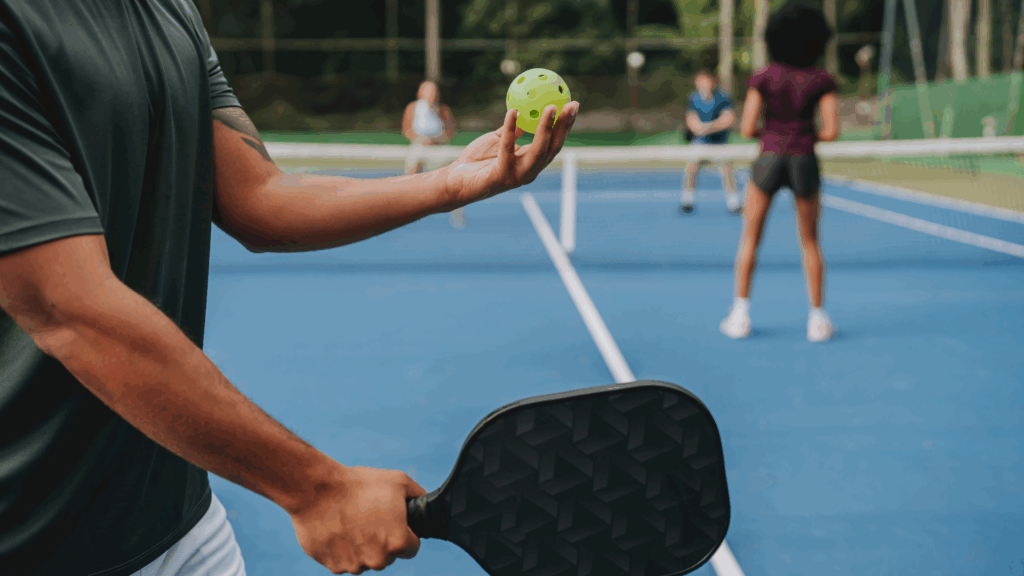
THIRD SHOT DROPS
When the return comes sizzling back, your third shot sets the tone—float a perfect drop and you move smoothly into the no-volley zone, miss and you play defense from the baseline.
Purpose And Strategic Value
Neutralizer: A well-placed drop erases the returning team’s positional edge by forcing them to hit up on the ball.
Transition Tool: It buys you and your partner time to advance from baseline to kitchen line in sync.
Pressure Gauge: Consistent drops make opponents think twice about rushing the net, opening the door for an occasional third-shot drive.
Drop Or Drive Decision Framework
Both opponents press the kitchen line: choose the soft drop to land safely in the front third of the kitchen.
At least one opponent lingers deep: rip a controlled drive to their feet, then look for a floating reply.
Wind or sun in your face: default to the higher-percentage drop; heavy conditions shrink drive margins.
Game score tight: favor the safest option you can execute eight times out of ten.
Mechanics Checklist
Grip Pressure: Medium-loose to absorb pace without popping the ball.
Contact Point: Just ahead of lead hip with paddle face slightly open.
Swing Path: Smooth upward arc, finishing high for ideal loft.
Clearance Target: One paddle height above the net; any lower courts disaster, any higher gifts time.
Landing Zone: Two to three feet inside the net, centered when possible to limit angles.
Core Practice Drills
Classic Partner Feed
Partner feeds a deep return.
Player executes drop; ball must land fully in kitchen.
Switch roles after ten clean drops.
Goal: Reach forty successful drops out of fifty attempts.
On-The-Run Drops
Start outside singles sideline, sprint to baseline center, hit drop on the move.
Mimics scramble situations when pulled wide.
Complete three sets of ten reps, alternating forehand and backhand.
Decision-Maker Live Rally
Coach positions as returner; sometimes stays back, sometimes charges net.
Player must decide drop or drive based on coach’s movement.
Track correct choices; aim for a 70 % smart-shot rate before adding pace.
Common Errors And Fixes
Flat Contact Leads To Sail-Long: Open paddle face one degree more and finish higher.
Popped-Up Drops: Grip too tight; relax wrist and shorten follow-through.
Short-Of-Net Misses: Ball struck late; step forward sooner so contact stays in front of body.
Failure To Advance: Admiring your shot is not a tactic—move as soon as the ball leaves the paddle.
Progression Benchmarks
Beginners: land five consecutive kitchen drops under no pressure.
Intermediates: achieve 30-ball streak with partner feed while advancing to NVZ.
Advanced: vary drop depth by six-inch increments on command, then pair each drop with immediate split-step at the line.
Game-Day Application
Signal partner before serve so both know the plan: drop and crash or drive and hold.
After a successful drop, expect opponents to counter with a dink; be ready to transition into soft-game mode.
Mix an occasional third-shot drive once drops establish respect; unpredictability wins rallies.
Mastering the third-shot drop blends touch, timing, and tactical reading. Drill with purpose, track your success rates, and soon the baseline will feel like a brief stopover rather than a permanent home.
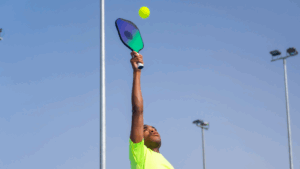
5 Quick Pickleball Drills You Can Do in Under 15 Minutes
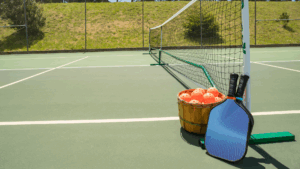
Court Ready in No Time: Essential Warm-Ups for On-the-Go Players
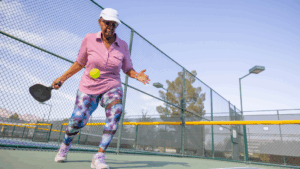
How to Add Spin to Your Pickleball Serve for a Competitive Edge
Volleys & Net Play
Owning the non-volley zone (NVZ) is where matches swing—develop quick hands, smart resets, and opportunistic attacks to turn kitchen skirmishes into easy points.
Fast-Hands Reflex Drills
Rapid-Fire Feed: Coach volleys 50 balls chest-high; player blocks each one with minimal backswing to sharpen reaction time.
Ping-Pong Deflect: Use a mini-paddle and ping-pong ball; rally for 30 seconds to shave milliseconds off response speed.
Two-Ball Chaos: Partner feeds two pickleballs alternately; player must volley each in sequence, forcing paddle readiness and foot adjustments.
Punch Volley Mechanics
Contact Point: Paddle out front, elbow slight bend, wrist firm.
Path: Short forward punch ending above net tape for a downward angle.
Drill: Ten punch volleys cross-court, then ten down the line; track landing depth—aim for mid-court or deeper to prevent counter-attacks.
Block Volley Resets
Grip Pressure: Looser hold acts like a shock absorber, deadening pace.
Face Angle: Slightly open paddle, letting ball drop softly into kitchen.
Recovery Step: After contact, replace paddle in ready position and reset stance immediately.
Metric: In practice, complete 20 consecutive block volleys without sending ball past the NVZ line.
Offensive NVZ Lob
Trigger: Both opponents lean forward inside the kitchen.
Execution: Wrist-loaded flick plus leg drive lifts ball four feet above opponent’s reach.
Depth Goal: Land within two feet of the baseline to force a scramble.
Safety Net: Practice 15 reps each side before match play; short lobs equal free overheads.
Rule Nuances At Net
Momentum Fault: Ends when swing completion stops, allowing aggressive follow-through as long as feet stay out of NVZ.
Partner Positioning: One partner may stand in kitchen while the other volleys, provided they do not touch.
Fault Transparency: Either player can call a partner violation; unresolved disagreement defaults point to opponents.
Common Errors And Fixes
Pop-Up Volleys: Paddle under ball at contact—flatten face angle and engage core for stable platform.
Hitting Into Net: Reaching late—split-step sooner and move feet rather than extending arms.
Over-Swinging: Large backswing invites errors—practice punch motion with a six-inch travel limit.
Static Feet: Freeze after volley—add a recover step back to ready stance to handle next shot.
Match-Day Tactics
Staggered Stance: One foot slightly behind the other for balance and quick lateral push-off.
Target Padding: Aim volleys three feet inside sidelines to eliminate risk while still pressuring opponents.
Speed-Up Signals: Agree pre-point that a shoulder-high dink will trigger an attack; the non-hitter closes middle ready to clean up.
Reset Mentality: If a volley exchange feels rushed, choose a soft block to regain control rather than forcing a winner.
Progress Benchmarks
Beginner Goal: Punch 10 of 15 practice feeds deep without errors.
Intermediate Goal: Sustain 20-shot volley rally with partner, alternating pace every fifth ball.
Advanced Goal: Execute offensive lob winner one in five attempts during live play without conceding easy overheads.
Hone these volley and net-play skills until reactions feel automatic and strategic choices flow naturally. Solid hands win the kitchen—and winning the kitchen wins the match.
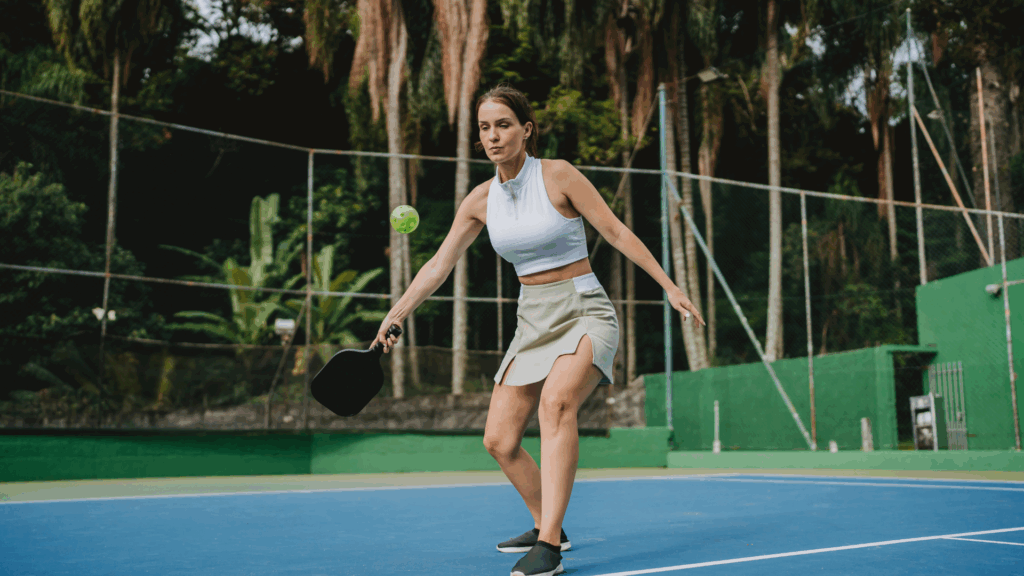
Footwork Drills
Swift, balanced feet turn good strokes into great ones, keep injury risk low, and let you arrive early enough to choose rather than chase your next shot.
Dynamic Warm-Up Routine
Jog Baselines: Light jog from baseline to baseline for one minute to raise core temperature.
High-Knees And Butt Kicks: Twenty-yard bursts each direction to prime hip flexors and hamstrings.
Lateral Shuffles: Two sideline laps staying in a low athletic stance to activate glutes and groin.
Dynamic Hamstring Kicks: Ten kicks per leg, reaching opposite hand to toe for controlled range of motion.
Goal: Finish warmed up in under five minutes so first rally feels sharp, not stiff.
Agility Ladder Patterns
In-In-Out-Out: Two feet in, two feet out of every rung to rehearse explosive split steps.
Ickey Shuffle: In-in-out diagonally down the ladder, building lateral drive crucial for NVZ coverage.
Two-Feet-In: Jump into each square with both feet, landing softly to train balance on forefoot.
Progression: Complete each pattern twice without clipping a rung; when flawless, shave total time by ten percent.
Cone Shuffle Series
Four-Cone Box: Cones form a ten-foot square; shuffle clockwise for thirty seconds, then counter-clockwise.
Zigzag Chase: Cones in staggered line; sprint forward two cones, shuffle back one, repeat to the end.
Drop-Step Drill: Start at center cone, drop-step and sprint to each corner on coach’s call.
Metric: Maintain knee-high ready stance and quiet feet—no crossing legs—through every rep.
Balance And Injury Prevention
Single-Leg Stands: Balance on one leg while volleying gentle tosses; switch legs every ten hits.
Bosu-Ball Squats: Ten controlled squats per set to strengthen stabilizers that guard ankles and knees.
Jump-Rope Rounds: Three rounds of sixty seconds, focusing on quick, light rebounds to fortify calves and Achilles.
Key Cue: Keep chest tall and engage core; wobbling trunk often precedes rolled ankles or back tweaks.
Tech-Powered Fitness
Wearable Tracking: Use readiness scores from devices to adjust session intensity—high fatigue suggests focusing on form, not max speed.
AIM7 Pickleball Fit App: Delivers daily mobility and recovery plans, reducing guesswork around warm-up length and cooldown needs.
Data Feedback Loop: Record ladder and cone times in the app; aim for steady weekly improvement without exceeding recommended load.
Progress Benchmarks
Beginner: Complete full warm-up and one ladder pattern without missing a rung.
Intermediate: Finish all ladder and cone drills in eight minutes while maintaining form.
Advanced: Cut total drill time to six minutes and execute single-leg volley stands for twenty straight hits per side.
Common Errors And Quick Fixes
Dragging Feet: Lift knees slightly higher during shuffles to avoid tripping.
Upright Posture: Bend at hips and knees; a lower center of gravity boosts acceleration.
Skipping Recovery: Stretch calves, quads, and lower back for two minutes post-session to lock in mobility gains.
Integrate these footwork drills three times each week, monitor metrics, and you will glide into position rather than lunge last-second. Quick feet not only win points, they keep you healthy enough to log more court hours—an unbeatable combo.
Partner Communication
Winning doubles isn’t just about great strokes; it’s a constant conversation in motion, where two voices, two sets of eyes, and one shared plan keep rallies tidy and pressure flowing toward the other side.
Essential Verbal Cues
“Mine” / “Yours”: Claim balls clearly to prevent the dreaded center-court clank.
“Switch”: Call instantly on lobs or sharp angles so both players rotate without hesitation.
“Middle”: Alert a poach opportunity—usually forehand in the middle finishes the point.
Volume Rule: Speak slightly louder than normal park chatter; wind and crowd noise can swallow half-hearted calls.
Consistency Metric: Aim for a clean, decisive call on every joint-decision ball during practice points—no silent shoulder-shrug rallies allowed.
Non-Verbal Systems
Hand Signals: Behind-the-back gestures pre-serve signal poach, stay, or fake; partners nod to confirm.
Eye Contact Check: Quick glance before returns ensures both remember the plan.
Paddle Tilt: Subtle tilt toward middle or line can cue intended target on speed-ups without tipping off opponents.
Reset Tap: Light paddle-to-paddle tap after long exchanges resets focus and diffuses tension.
Body Position: Slight stagger—one foot up, one back—telegraphs who covers center if a speed-up erupts.
Team Drill Ideas
Gap Attack: Two defenders hold NVZ, single attacker aims every ball to seam; defenders must call ownership before paddle motion.
Third-Shot March: Serving team practices drop, announces “Go” while advancing; partner shadows stride and echoes “Go” to confirm.
Lob Coverage Relay: Coach feeds alternating lobs; back player shouts “Me,” front drops into split-step and shouts “Switch” after overhead.
No-Talk Penalty Round: Teams play three rallies silent, then replay same points with full communication; score difference highlights call value.
Positive Mindset Habits
Start each match with one uplifting phrase: “Let’s play smart and have fun.”
Use present-tense encouragement after errors: “Next one” beats “You always miss those.”
Create a reset routine for tight spots: tap paddles, exhale, call strategy in four words or less.
Celebrate micro-wins: a well-placed dink or smart leave gets a quick “Nice!” to keep morale climbing.
Debrief wins and losses together: five-minute recap covers what worked, one thing to improve, and a mutual fist-bump.
Sportsmanship Rules That Influence Calls
Either partner may call their own fault: honesty preserves reputation and flow.
If partners disagree on a line call: the point automatically goes to opponents—clarify responsibility zones pre-match.
Avoid coaching mid-point: brief directional calls are legal, but extended advice while ball is live breaks the spirit of play.
Momentum at net: partners cannot steady each other mid-volley; physical support constitutes an NVZ violation.
Quick apologies for accidental body shots ease tension and keep partnership chemistry intact.
Common Errors And Quick Fixes
Double Commit: Both charge middle; fix by assigning forehand priority and practicing seam drills.
No Man’s Land Drift: Players hover at service line; set rule that whoever hits third shot must yell “Up” and both crash.
Silent Treatment After Miss: Briefly acknowledge mishit—“My bad”—then re-engage; silence breeds frustration.
Command Overload: Too many words delay reaction; restrict in-point chatter to single-syllable cues.
Negative Loops: Harsh self-talk spreads; agree to replace “I can’t” with “I will next time.”
Partnership Growth Benchmarks
Beginner Pair: Execute clear “Mine” / “Yours” calls on 90 % of shared balls in one practice set.
Intermediate Pair: Run Third-Shot March drill for ten consecutive drops without positional confusion.
Advanced Pair: Vary stacking formations seamlessly for five games, maintaining serve-receive win rate above 70 %.
When two players move and speak as one, unforced errors vanish, attacks feel inevitable, and opponents’ seams grow wider than the court. Drill these habits until calls become reflexive whispers and trust feels automatic. Then bring the synergy to league night, and watch tight matches tilt your way.
READY TO PLAY? LET'S PICKLEBALL!
Pickleball’s rapid rise across the United States has created a golden era for skill development, community connection, and tech-driven learning—if you follow the right plan, you can leapfrog guesswork and accelerate progress in record time.
Ready for the next step? Slide your phone open, set a drill reminder, and block the calendar for your first focused session this week. Then head over to the community hub for deeper breakdowns, printable drill sheets, and pro interviews that dissect advanced tactics down to the grip pressure.
Read our Pickleblog for more insights and resources:
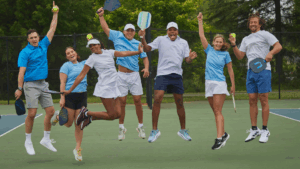
Stylish and Functional: Pickleball Apparel That Works on and off the Court
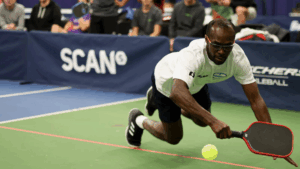
A Beginner’s Guide to Joining a Pickleball League Without Overcommitting
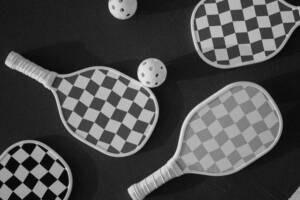
Pickleball Etiquette: What to Do (and What Not to Do) on the Court
